It is a computer of limited scale, but designed for global consensus, extreme robustness, and decentralization, which anyone anywhere in the world can trust to run continuously exactly as programmed.
The following is the full text of Vitalik Buterin's opening speech at Devconnect ARG 2025, translated from English.

One-sentence summary of Ethereum: It is not FTX
I want… to summarize Ethereum in one sentence. Who here remembers FTX? (Please raise your hand) How about Mt. Gox? (Please raise your hand) Okay, quite a few people.
I actually don't have much negative feeling towards Mark Karpeles of Mt. Gox. I think he made a big mistake, but after that, if you look at every action he took, I believe he has been trying to learn, adapt, and commit to positive-sum security matters.
But FTX, I think it is a perfect example that precisely shows what you would get if you took the principles of Ethereum and completely flipped them 180 degrees. And it's not me putting his face (SBF) up there. Every FTX advertisement prominently featured SBF's face, five times more noticeable than any other element.
So, to summarize Ethereum in one sentence: It is not something like FTX.
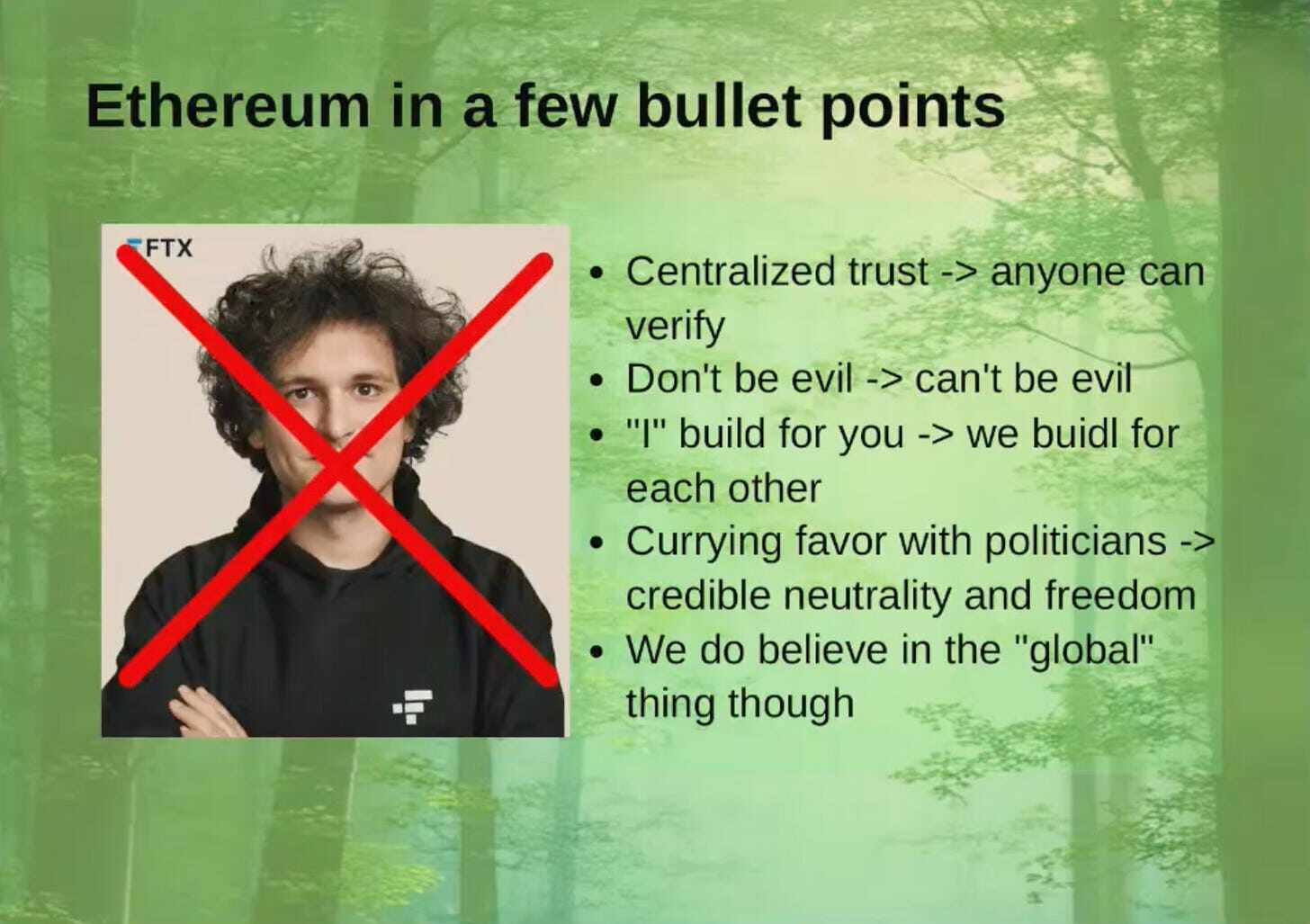
Key points about Ethereum:
1. From "centralized trust" to "anyone can verify"
FTX is a centralized exchange where people invested huge amounts of money. You could not verify whether FTX was actually solvent. Of course, it was ultimately proven that it was not.
2. From "don't be evil" to "can't be evil"
"Don't be evil" was Google's famous early idealistic slogan, especially when it was still a small company. It seemed to take pride in being a company that created positive-sum value. However, as Google grew, those positive values began to erode over time, and eventually, this motto was officially abandoned in the past decade, now seeming to have turned into something more mundane like "do the right thing."
The approach of the previous generation of technology, and the many consequences we have seen from it, is to stand up and shout: "Trust me, because I am a good person."
The point of decentralized technology and blockchain is that you do not have to trust them.
3. From "I build for you" to "we build for each other"
Another significant distinction is between "I build for you" and "we build for each other." There is a very subtle but, I think, extremely important difference between companies and communities.
Another example that comes to mind is Estonia's e-Residency. I am actually a bit hesitant to criticize it because it is indeed very innovative and has many positive aspects.
It was very ahead of its time, allowing you to open bank accounts digitally, vote digitally, and do a lot of e-government. I remember one of the more idealistic visions of that project was that Estonia would expand into a digital nation. e-Estonia could be much larger than the physical Estonia with 1.3 million residents.
The challenge is that it misunderstands what a real community is.
e-Estonia is very successful as a service provider; it is a hub and spoke structure. You have a central entity (the Estonian government) providing services. Their services are very valuable and have helped many people around the world (for example, obtaining EU bank accounts).
But it is not a community. The difference between a company and a community is:
- A company is a hub and spoke structure: there is a central entity doing things and making money.
- A community is where everyone (or a very large number of people) is doing things for each other.
It is open—not just in the sense of OpenAI (having an open API you can use), and not just in the sense of many open LLM works.
It is open in the full-stack sense, open not only to consumption but also to creation.
4. From "pleasing politicians" to "trustworthy neutrality and freedom"
Also, in the old model, "pleasing politicians" has turned into (what Ethereum pursues) "trustworthy neutrality and freedom."
Ethereum is a global network that exists for the world, aimed at protecting the freedom of people worldwide. It is not about pleasing a specific company or a superpower at the expense of everyone else.
We truly believe in "globality." If you think the term "globality" is too "soy" or something, you can also use terms like "local universe" or "cosmolocal." There are many different words, but we are here to impact the world.
What is "Ethereum, the world computer"?
So, let's talk about Ethereum, the world computer.
Ethereum is a global, open, censorship-resistant platform for building decentralized applications.
A new block is generated every 12 seconds, and each block contains a bunch of transactions. The blockchain processes slightly under 2 million transactions daily. I think with the increase in the gas limit, it will soon exceed 2 million.
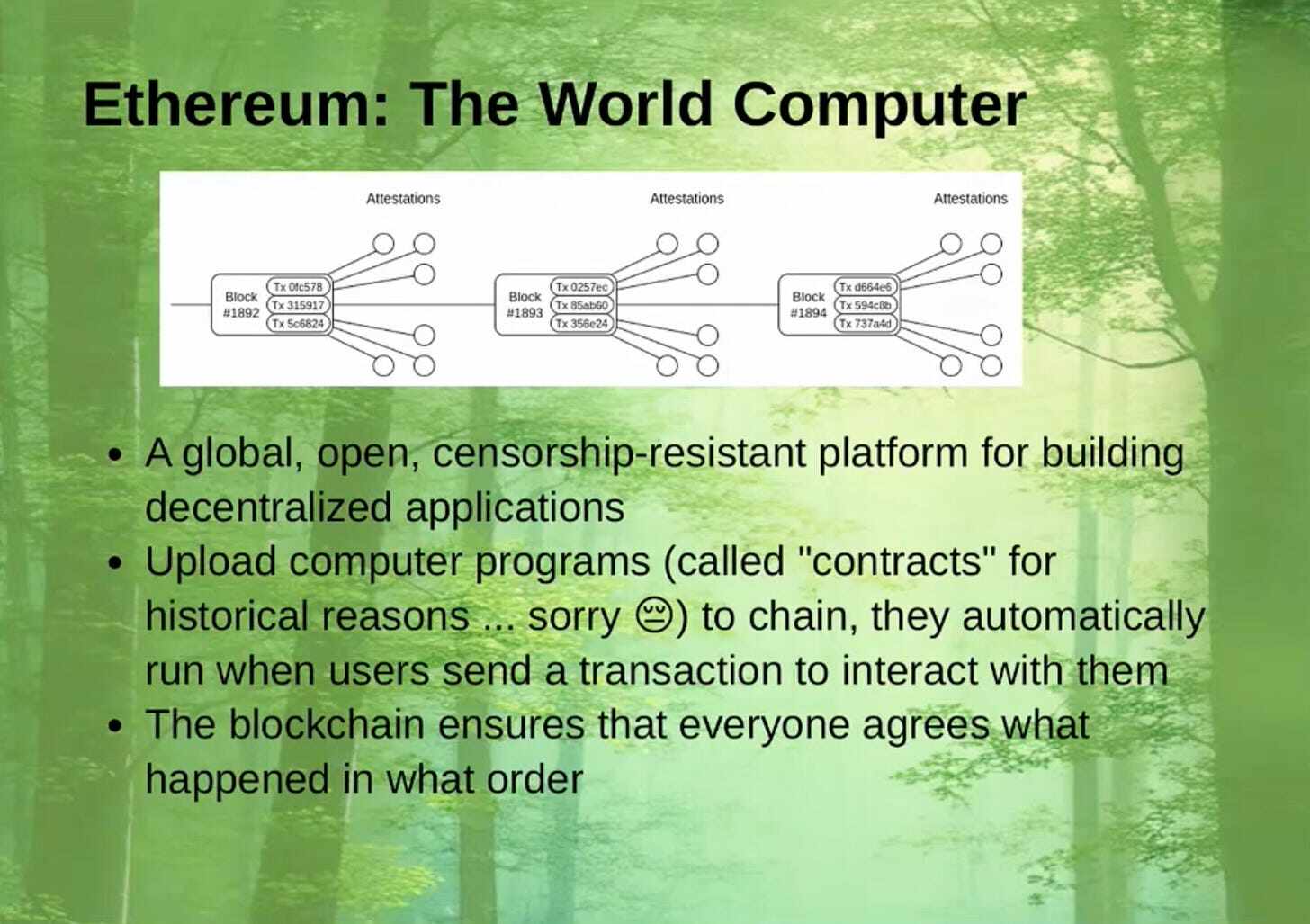
Then there is the consensus mechanism. It used to be Proof of Work, and now it is Proof of Stake. The job of the blockchain is that, as a user, anyone can send transactions (essentially instructions of "what I want to do"), and the blockchain ensures that everyone agrees on what happens (like which transactions were sent and in what order).
Programmability: The core distinction of Ethereum
The main distinction of Ethereum from previous technologies is programmability.
Previous blockchains were either single-purpose protocols (used for a specific application) or what I call "Swiss Army knife" protocols—where developers say, "Here are 14 different applications, and we create 14 different transaction types to support them." If someone discovers a 15th application, we would have to hard fork the protocol.
Ethereum embraces programmability. Whatever application you want to build, you can upload a computer program.
Due to some historical reasons (related to Nick Szabo, early cryptography, etc., you can look it up), these programs are called "contracts." They are smart contracts.
Many legal professionals may get confused by the term "contract." So just know that "contract" here is a technical term. Just like "Promise" is a technical term in JavaScript.
You upload a computer program to the chain, and when users send transactions to interact with it, these programs run automatically.
So, on a technical level, that's basically it. It is the "world computer": not that it is a computer big enough to handle all the computations in the world (including all the crazy LLM inferences and cat video generation).
It is a computer of limited scale, but designed for global consensus, extreme robustness, and decentralization, which anyone anywhere in the world can trust to run continuously exactly as programmed.
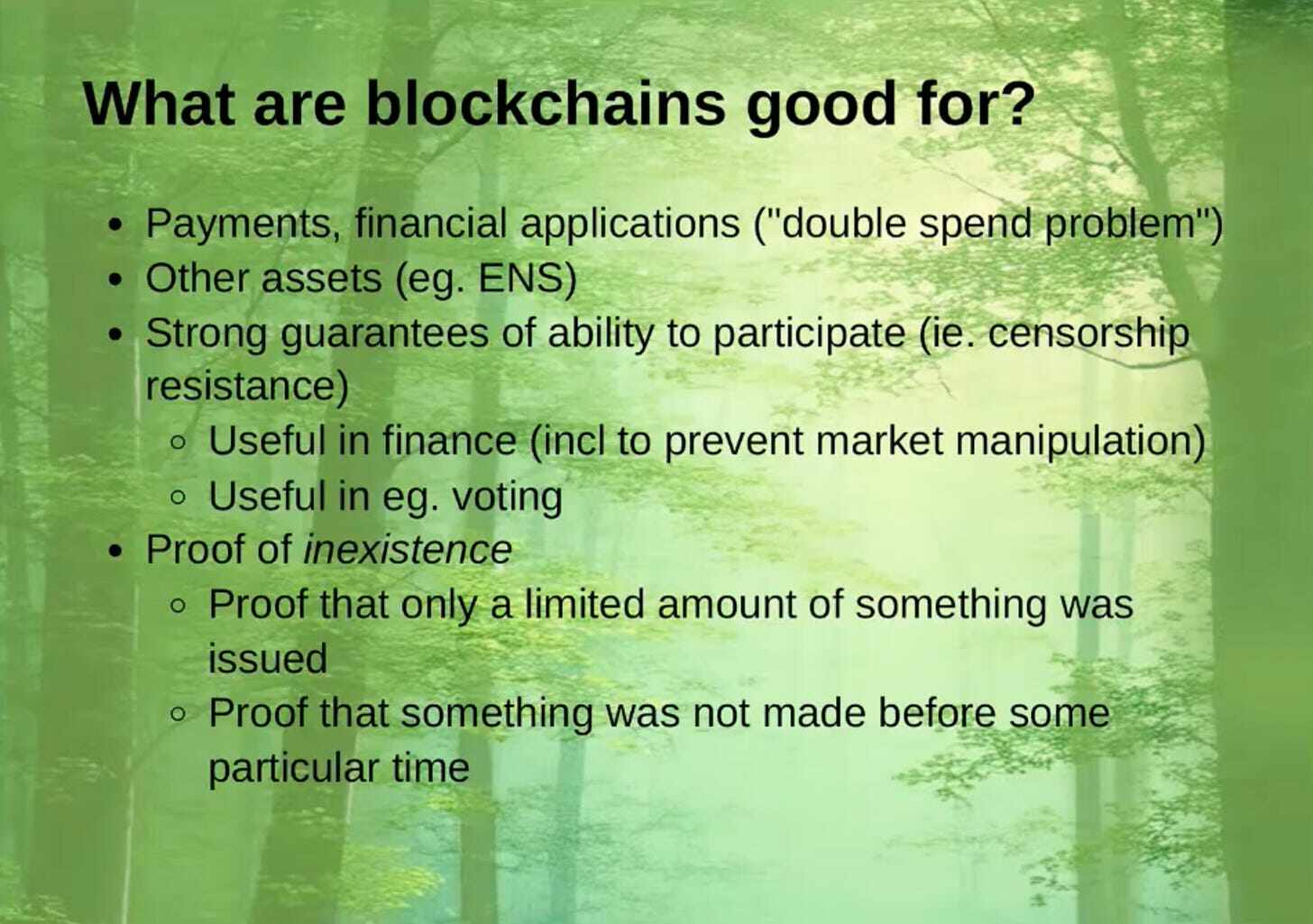
What is blockchain good at?
1. Finance and DAOs (solving double spending)
Clearly, the first and largest category is payment and financial applications. The first blockchain, "Bitcoin," was born as peer-to-peer electronic cash. Even in Ethereum, if you look at the Ethereum white paper, about half (or even more) of the applications that inspired Ethereum are different types of financial applications: issuing assets, asset exchanges, financial derivatives, and even prediction markets.
There are also DAOs (Decentralized Autonomous Organizations). These systems encode the rules of organizations (like companies) on-chain, and then these rules directly control the assets owned by the organization.
Blockchains tend to excel at these things, one commonly cited reason being: blockchain solves the double spending problem.
You might ask, why do we need the concept of "consensus"? Why do we need proof-of-stake nodes to vote on what transactions happen in what order?
What would happen without consensus? What if we only had a decentralized network like BitTorrent? You can upload files on BitTorrent, and anyone can download them. You could even (theoretically) have files that contain programs and run them automatically.
To understand why that kind of mechanism does not work for currency, the simplest question is this "double spending" problem.
The problem is, suppose I have 1 ETH, and I send 0.7 ETH to someone over there. I broadcast that transaction. Then, I simultaneously send another transaction giving 0.7 ETH to another person over here.
In total, I have turned 1 ETH into 1.4 ETH. If people could do this, ETH would experience hyperinflation and become worthless.
If you do not want this to happen, you need a way to arbitrate which transaction happens first. That is the role of the blockchain.
2. Non-financial applications
Blockchains are also very useful beyond finance.
Perhaps the most successful non-financial application is ENS (Ethereum Name Service), which I am sure you will hear about in many places this week. You can basically have your own name. You can register an unoccupied .eth domain (I have Vitalik.eth).
This is a username that is recognized as your username across all Ethereum applications, and it is not controlled by any single service provider. It is not like a Google account or a government-issued name.
3. Censorship resistance and proof
Blockchains provide strong guarantees of participation, also known as censorship resistance. It strongly guarantees that if you send a valid transaction (i.e., one that complies with the protocol rules), it will be (and quickly will be) packaged. This is valuable in many areas, such as preventing market manipulation in finance.
Blockchain excels at "proof of inexistence," which means proving that only a limited number of items have been issued. For example, if you want to issue 1,000 stamps representing community membership, you can prove that you only issued 1,000 and not 10 million, demonstrating that you do not have any hidden stash.
It also applies to timestamp proofs: proving that something was not created before a certain point in time; or conversely, proving that something was created before a certain point in time. This is useful for video authentication and other use cases.
So, blockchain is a diverse tool, with both financial applications and other interesting "long-tail" applications.
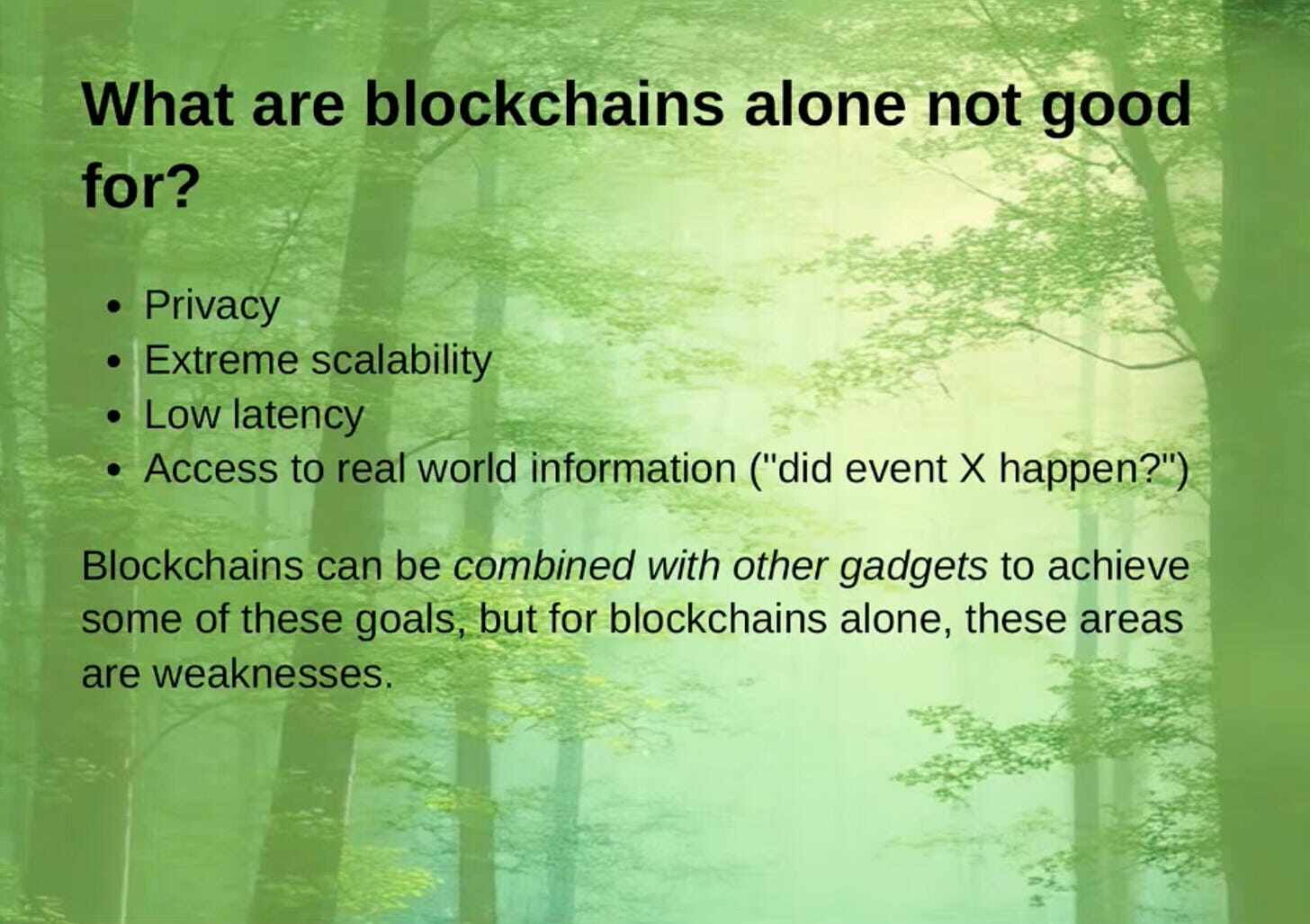
What is blockchain not good at?
1. Privacy
Zooko from Zcash once famously said that Bitcoin is "Twitter for your bank account." Who here would want all their financial transactions to automatically turn into tweets?
But you must realize that if the transactions you send on the blockchain are not private, if someone really wants to, they can easily create a Twitter bot that automatically waits for you to send transactions, analyzes them with an LLM, tries to figure out who you sent them to, and then tweets about it. This is closer to "Twitter for your bank account" than you might think.
2. Extreme scalability
If you want to run an LLM program on Ethereum to generate a cat picture, you might end up spending millions of dollars in transaction fees.
3. Low latency
This is an inherent cost of decentralization. If you want a geographically distributed, neutral system that everyone in the world can participate in, it cannot have a latency of 50 milliseconds. If it really had (such low latency), then all activities would ultimately concentrate in one city.
4. Accessing real-world information
This is the "oracle problem." For example, deciding a payment based on whether something happened. Ethereum itself cannot solve this major trust issue, which is that you still need someone to tell you the information: Did that thing actually happen?
Blockchains can combine with other "gadgets" to achieve these goals, but for the blockchain itself, these areas are weaknesses.
The Bigger Picture: Web3 and Cryptography
Ethereum is part of a larger story. This image comes from Gavin Wood's vision in 2015, which was an early vision of Web3: Ethereum is one of a set of technologies that together create a freer and more open internet.
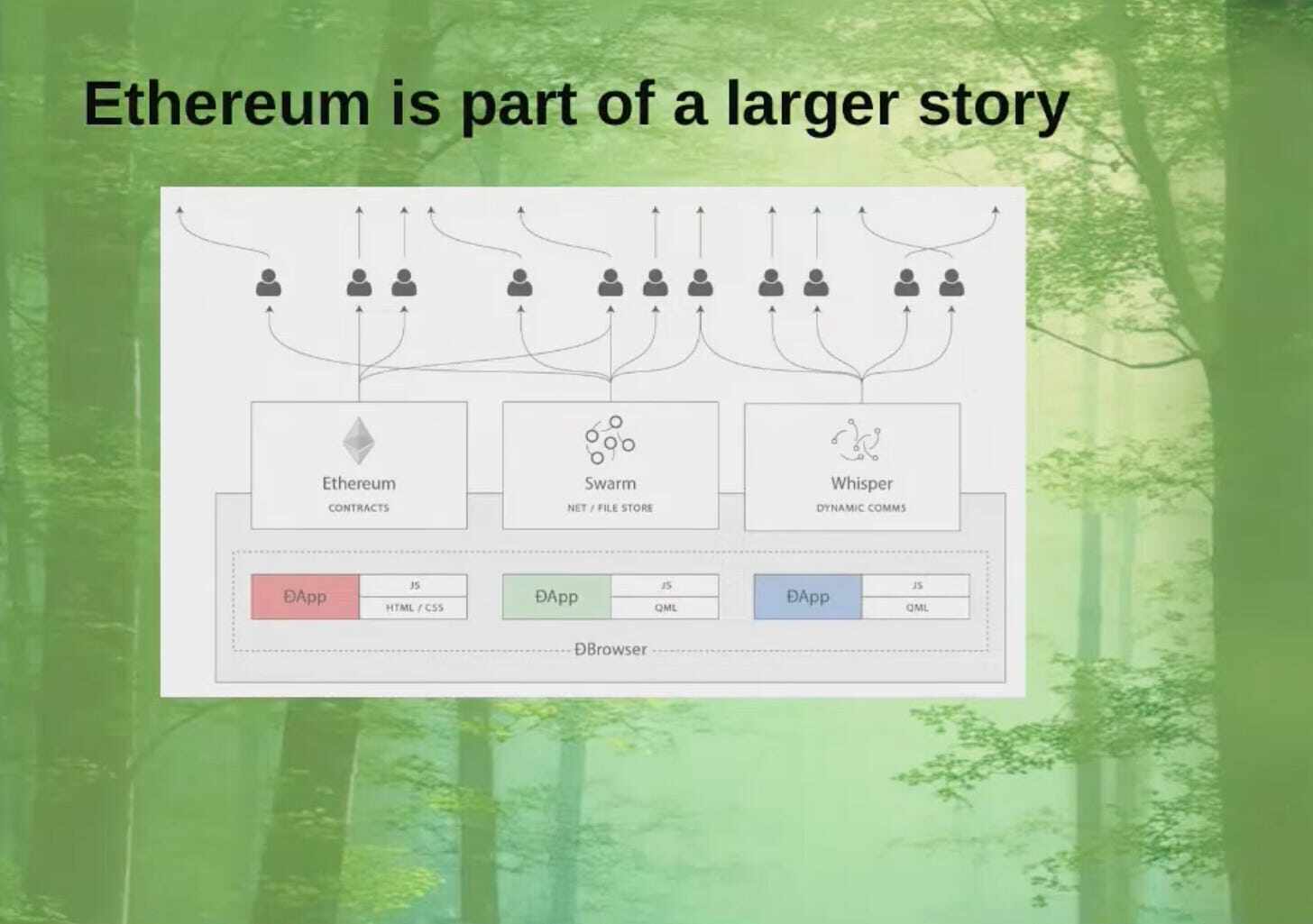
Blockchain is an important piece of this puzzle. But in 2015, there were also some sister protocols in development (and still are):
- Swarm: for distributed storage, handling data that is too large for everyone to download onto the chain.
- Whisper: an off-chain peer-to-peer messaging protocol that does not care about consensus.
These protocols are still ongoing: Whisper has evolved into Waku, which is used in many privacy protocols and instant messaging; the Swarm team is still active, and IPFS is being widely used.
But I think one big thing that has happened is that this "larger story" has expanded a lot. For me, this larger story is that there exists a class of technology called "cryptography."
Cryptography makes large-scale collaboration without centralized trust possible.
The most basic forms of cryptography are encryption and signatures.
- Encryption: allows you to talk to a friend 10,000 kilometers away, while anyone in between (including infrastructure operators) cannot see the content.
- Signatures: allow you to verify whether the information you received really came from the person it claims to be from.
Recently, we have seen the rise of programmable cryptography, which is a more advanced form. You can not only encrypt and sign, but also:
- Perform entire computations on encrypted data.
- Prove you possess certain data without revealing the data itself (e.g., ZKPs - zero-knowledge proofs).
- Combine data from multiple people for computation (e.g., FHE - fully homomorphic encryption).
- (Further out) Obfuscation: take a program containing your data and only use it to do specific things.
This is a whole set of tools that enables large-scale collaboration without centralized actors. Blockchain complements this in many ways.
The Future of Ethereum
Our high-level goal is:
We want a secure, robust, streamlined, globally decentralized, censorship-resistant network that possesses all the features people have expected from blockchains since the birth of Bitcoin.
But within these constraints, we also want it to be fast and scalable, so that applications wanting to benefit from these features truly have the space and capability to do so.
2025-2026: Scalability Arc
The gas limit (a measure of how many transactions Ethereum can handle) has already increased by 50% this year. There is currently a proposal to raise the gas limit to 60 million (currently about a quarter of the nodes are voting in support, and I believe that number will continue to grow).
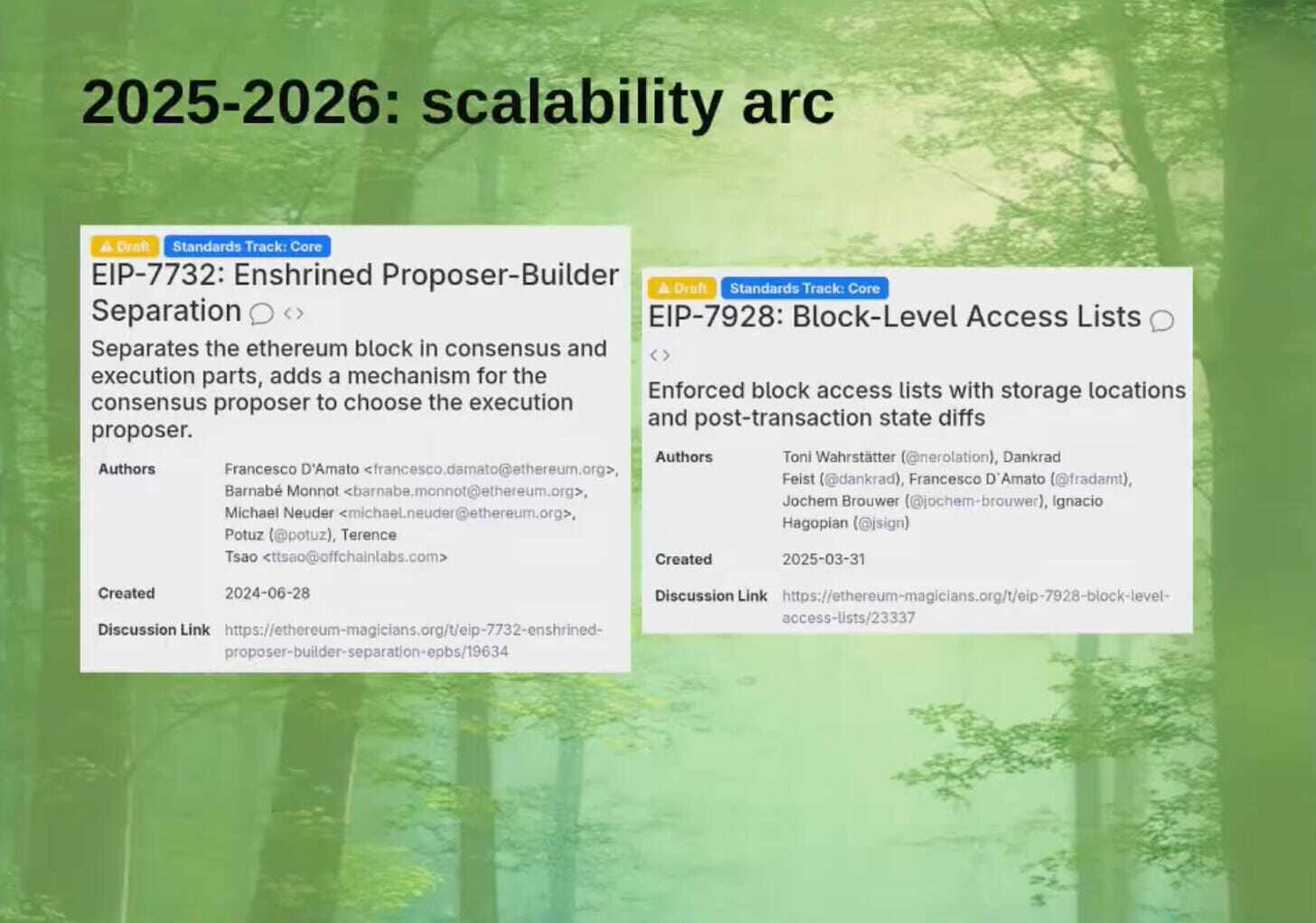
In 2026, we will have a series of EIPs that will allow the Ethereum network to safely handle larger scales while maintaining decentralization and the operational capacity of regular nodes.
- EIP-7732 (Native Proposer-Builder Separation, PBS): One of its effects is that it allows nodes to spend a larger portion of their slot time processing blocks without compromising network decentralization (or severely favoring centralized nodes).
- Block level access list: This essentially means that all other nodes, except for the node that initially created the block, can process that block in parallel.
With the "block level access list," this issue is largely solved for every node except the one creating the block, which is truly remarkable.
These two things will enable us to achieve a more secure gas limit increase by the end of next year, making Ethereum perform better than at the end of this year.
ZK-EVM: The Return of Full Node Culture
Next is something I am very excited about: ZK-EVM, and the return of full node culture.
Who here ran an Ethereum full node 5 to 8 years ago?
Who here is running an Ethereum full node today?
Okay, the numbers are about the same, but that is still far from enough.
I remember the last time I synced a full node, it took me four days. Four days is too long. It also takes up more than 1 TB of space on your hard drive. And to keep it running, it requires a lot of computation, drains the battery, and can cause your hard drive to fail faster. It is an expensive endeavor.
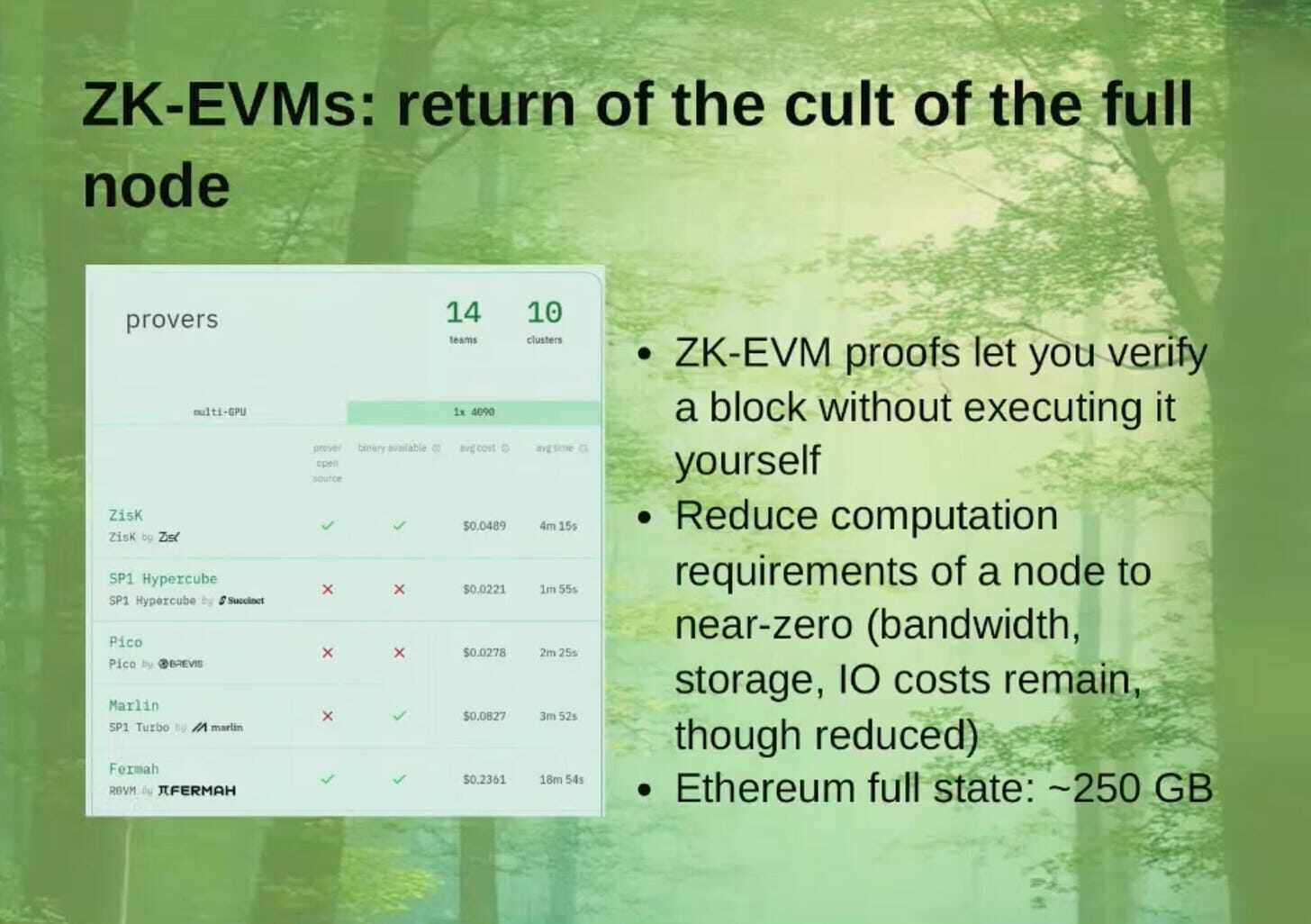
ZK-EVM, based on the zero-knowledge proof technology I mentioned, allows you to verify the correctness of a block without having to execute all the computations yourself.
This is no longer science fiction. It is now about to become a reality in the Alpha stage.
According to data from ethproofs.org, there are now provers capable of proving Ethereum blocks in real-time using dozens of consumer-grade GPUs, and this number is rapidly shrinking every few months.
We can reduce the computational requirements for nodes to nearly zero.
Of course, bandwidth, storage, and I/O costs still exist, but they have also been reduced. Theoretically, if you have a laptop or even a phone with enough space (like 512GB, which is now available), you can start considering running a full node.
I believe that in the next one to two years, despite the scaling of Ethereum, the number of people who can actually run full nodes will increase significantly.
2026 to 2027: Censorship Resistance and Decentralization Upgrades
- FOCIL: Allows a medium-sized set of nodes to propose "mini-blocks" in each slot. This provides stronger guarantees that your transactions can be quickly packaged.
- Account Abstraction: Ongoing work to ensure you can have more powerful smart wallets, better security forms (like key rotation), and even support for privacy protocols, all of which do not rely on intermediaries.

Longer-term: Lean Ethereum
Justin's team has been researching "Lean Ethereum," a long-term effort aimed at making deeper improvements to ensure Ethereum remains efficient and secure in the long run. This involves replacing many suboptimal components with known components that are closer to optimal.
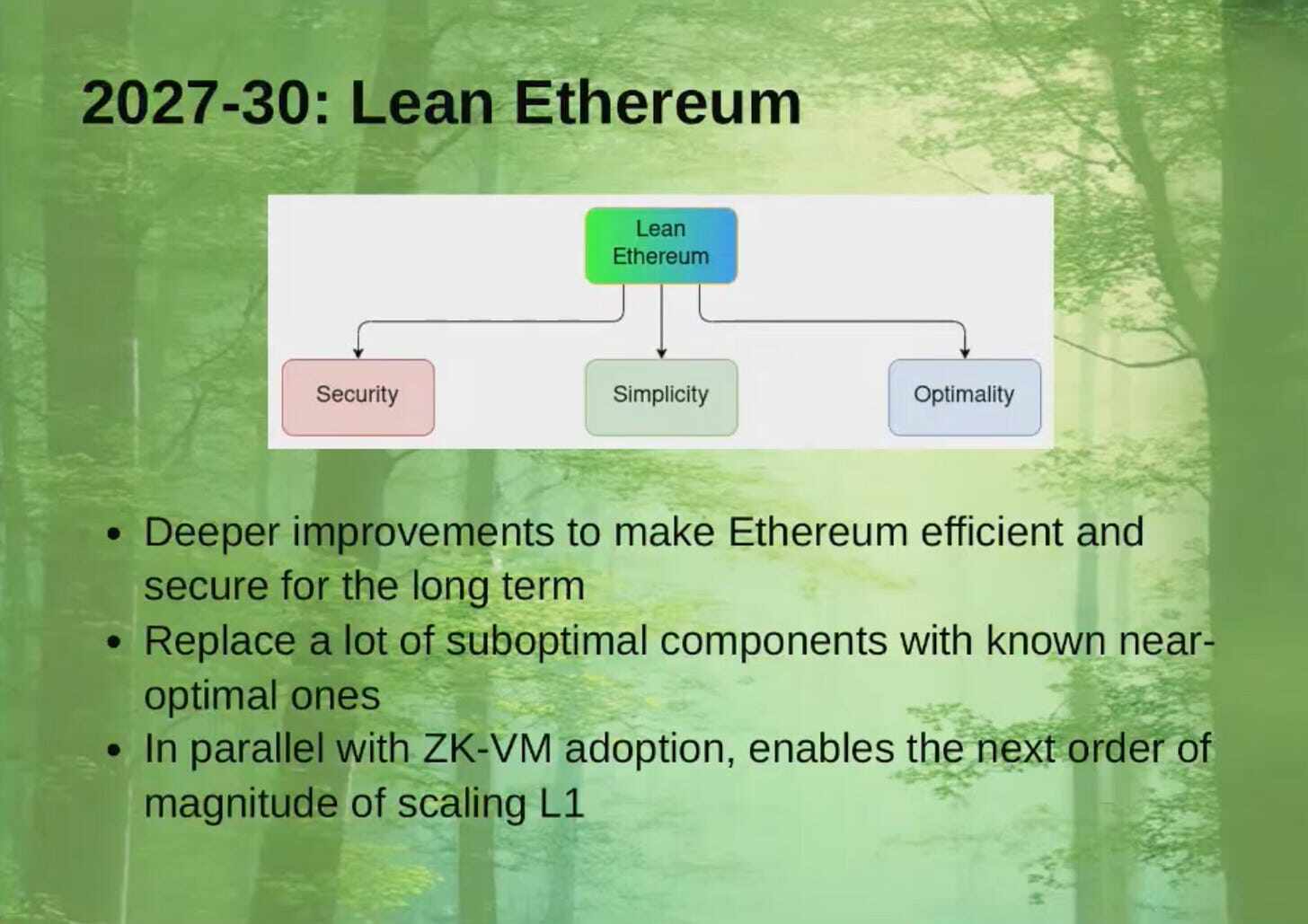
Key focuses include:
- Optimized, fast, ZK-friendly VM (virtual machine)
- Ubiquitous quantum resistance
- ZK-friendly hash functions (currently leading is Poseidon, and we are investing heavily in academic research and bounties to ensure its robustness)
- Formal verification of everything
- Optimized consensus (faster finality, Fast finality)
We are essentially drawing on all the lessons learned over the past five years and truly introducing those technologies that have only become possible and available in the last five years.
User-Level Work: Trustless User Experience
This includes privacy and security.
- Privacy: Not just on-chain ZK proofs. It also includes protecting you from privacy infringements by RPC nodes (from which you fetch data), network layer privacy, voting privacy, DeFi privacy, and even private account abstraction.
- Security: Light clients (like Helios) are improving. Reducing software supply chain dependencies (the amount of software we must rely on that could crash everything due to bugs). On-chain version control (getting rid of front-end dependencies on servers, preventing everything from being stolen if a server is hacked). Multi-signature, social recovery wallets, hardware wallets.
- Interoperability: There have also been related activities this week.
Ethereum can become a flagbearer, leading a freer, more open, and collaborative world supported by permissionless open technologies and decentralized trustless security.
This is a powerful technology that is rapidly becoming even more powerful. It is also part of a set of tools whose power is growing rapidly.
I believe the Ethereum community and Ethereum technology can truly help bring this freer, more open, and collaborative world into reality.
Let us work together to achieve this goal.
Thank you.
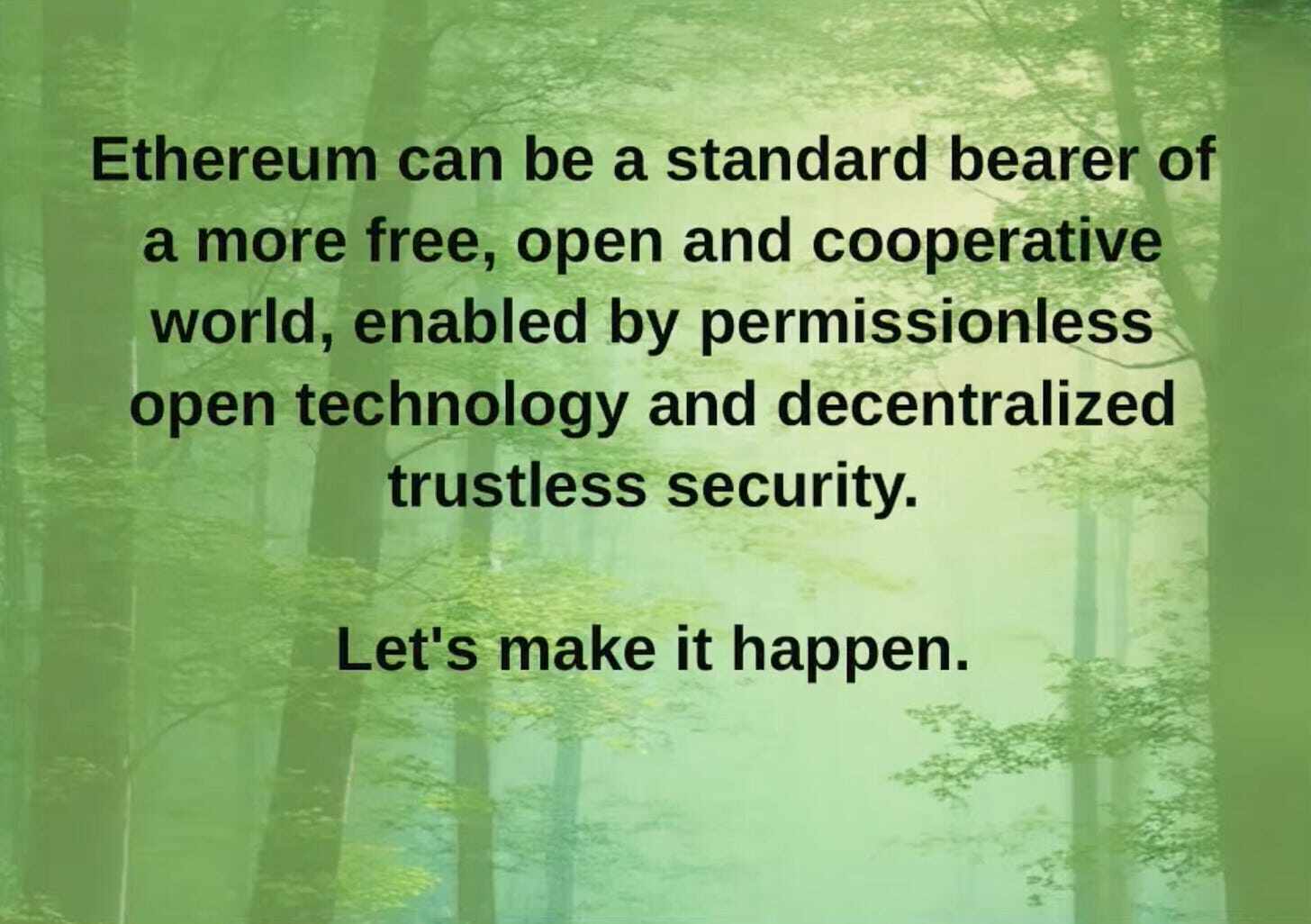
Q&A Session
Host: Alright, thank you very much, Vitalik. I think everyone knows what the first question will be, so I’ll just ask it directly. Where can we buy those glasses you are wearing?
Vitalik: I think they are available on Amazon. Unfortunately, we haven’t created a decentralized Amazon yet, so… maybe that’s a good idea for a hackathon.
Host: Okay, direct segue, similar question. What do you think about the relationship between Ethereum and Wall Street?
Vitalik: (…hears the question…) Wall Street. Well, I think they are a user. In Ethereum, we are "pro-user."
Host: Great. You’ve talked a lot about what Ethereum can become and its current state. What do you think are some underrated aspects that people could focus on to extend Ethereum's attributes into the real world?
Vitalik: Well, I think there are a few different dimensions.
One of them is the real-world adoption of Ethereum itself. The dream started with payments. I remember being very excited in 2013 when there was a "Bitcoin Kiez" in Berlin. (Does anyone remember that?)… In the Kreuzberg district of Berlin, someone convinced 10 restaurants within a few hundred meters to accept Bitcoin simultaneously. It became a Bitcoin cultural community. There was a lot of momentum around Bitcoin payments at that time, but it faded away for several reasons (I think rising transaction fees were one of the main reasons).
We now have the technology to make payments truly feasible again. And there is a lot of demand for crypto payments in Buenos Aires, where many physical stores even accept ETH and stablecoins on Ethereum.
I think even this real-world use is great.
Another thing is that when you examine this set of underlying technologies, in any field—whether it’s communication, governance, or lower-level stacks like operating systems, or even hardware—you can:
Think with the principles we talked about today. Consider how to make things more open, how to minimize the need for trust, and how to protect users. At the same time, think about some new technologies, including blockchain and cryptography, that allow us to move deeper in that direction than ever before.
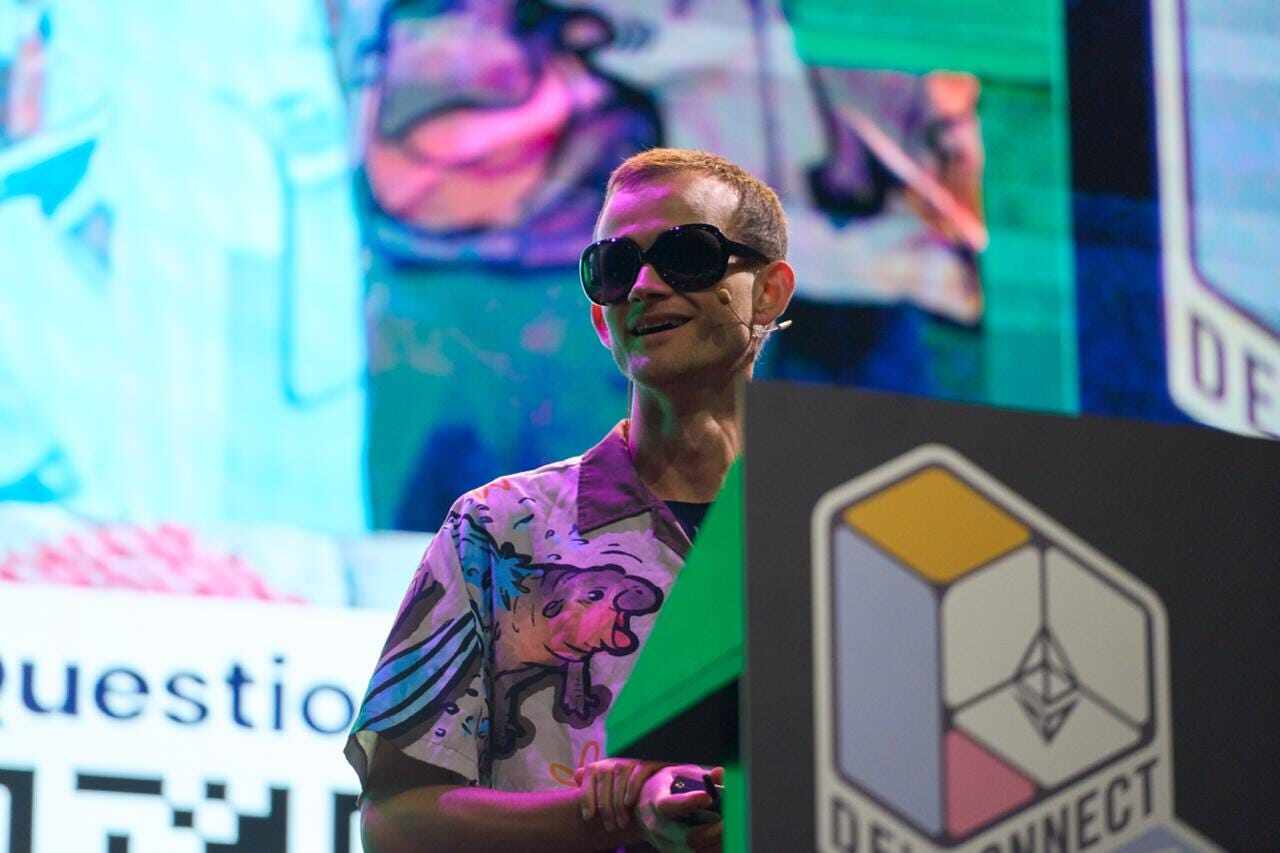
Host: For both new and old members of Ethereum, what is the most important skill that needs better training or improvement?
Vitalik: It depends on who you are, but I think for a community like ours, being well-rounded is always healthy. It’s always beneficial to dabble in several different aspects of this field.
So I encourage everyone to at least try paying for coffee with ETH this week; if you don’t have a wallet, install one; if you haven’t used a DApp, use one; if you haven’t written a smart contract, try writing one.
If you’re willing, you can even try to learn how one of the underlying protocols works.
At the same time, pay attention to how all these technologies interact with the broader world; Argentina has always been a good place for that, with a lot of adoption at various layers of the stack.
Host: Another question is, how did you come up with the name Ethereum?
Vitalik: I think I was browsing a list of elements from a science fiction novel, and I thought the word sounded nice.
Host: Great. What about the logo?
Vitalik: That’s an interesting story. I’m not sure exactly what happened, but I think "Ethereum" appeared on that list of science fiction elements because of a Japanese movie called "Castle in the Sky."
In that movie, one of the core objects is the "Ethereum crystal." The Ethereum crystal is what makes the castle float.
I had no idea about that origin at the time. But after I named it Ethereum, I think our artist might have known about that movie and then designed the logo to resemble the Ethereum crystal.
I remember it was about five years later that I first learned about and watched that movie, and I thought, "Wow, that crystal really looks like the logo."
Host: That’s amazing. I think that’s all the questions we have. Do you have anything else you’d like to say to the community? Maybe a lunch recommendation?
Vitalik: Well, eat something good, make sure to drink plenty of water, and spend some time outdoors enjoying the fresh air. You know, air is one of the four elements, and it’s important to keep it clean.
Enjoy the activities this week.
Host: Thank you very much, Vitalik!
免责声明:本文章仅代表作者个人观点,不代表本平台的立场和观点。本文章仅供信息分享,不构成对任何人的任何投资建议。用户与作者之间的任何争议,与本平台无关。如网页中刊载的文章或图片涉及侵权,请提供相关的权利证明和身份证明发送邮件到support@aicoin.com,本平台相关工作人员将会进行核查。




